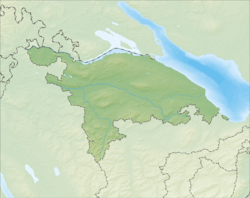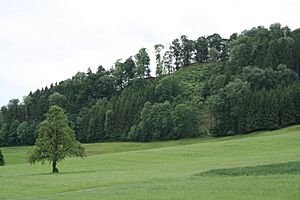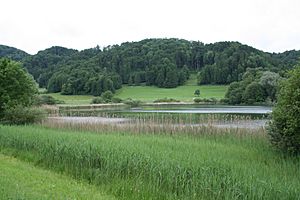Bichelsee-Balterswil facts for kids
Quick facts for kids
Bichelsee-Balterswil
|
||
|---|---|---|

Bichelsee village
|
||
|
||
| Country | Switzerland | |
| Canton | Thurgau | |
| District | Münchwilen | |
| Area | ||
| • Total | 12.26 km2 (4.73 sq mi) | |
| Elevation | 601 m (1,972 ft) | |
| Population
(Dec 2020 )
|
||
| • Total | 2,949 | |
| • Density | 240.54/km2 (623.0/sq mi) | |
| Postal code |
8362
|
|
| Surrounded by | Aadorf, Eschlikon, Fischingen, Hofstetten bei Elgg (ZH), Turbenthal (ZH), Wängi | |
Bichelsee-Balterswil is a town in the Münchwilen area of Thurgau canton in Switzerland. It was formed on January 1, 1996, when the towns of Bichelsee and Balterswil joined together.
Contents
History of Bichelsee-Balterswil
This town was created in 1996 when the two older towns, Balterswil and Bichelsee, became one. Bichelsee was first mentioned in old writings in 894 as Pichelense. Balterswil appeared in records in 885 as Baldherreswilare.
Bichelsee's Past
Long ago, a powerful family called Udalrichinger gave the village of Bichelsee to the Abbey of St. Gallen. Later, the Bichelsee family ruled the village for the Abbey. They first lived in Alt-Bichelsee Castle. In the early 1200s, they built a new castle, Neu-Bichelsee Castle. This new castle was destroyed in 1274 by the Habsburgs.
In 1358, Hermann IV of Landsberg-Greifensee bought Alt-Bichelsee Castle. He also gained control over Balterswil. In 1407, soldiers from Appenzell burned Alt-Bichelsee. After it was rebuilt, the Abbey of Fischingen bought the castle and land in 1419-21. Bichelsee stayed part of the Fischingen court until 1798.
The local church, St. Nicholas, was likely built in the 1100s. It was supported by Fischingen Abbey until 1769. In 1529, the village changed to the new Protestant faith. But in 1542, they returned to their old Catholic faith. The Protestant church members joined the Dussnang parish in 1550. St. Blasius church was shared by both faiths until 1954. A new Protestant church was built in 1960.
For a long time, farming and small businesses were the main ways people made a living. In the late 1800s, farming changed to focus more on dairy. Small home weaving and embroidery businesses were common in the early 1800s. They became less popular around 1900. In 1899, the first Swiss Raiffeisen bank was started here. Today, the Traxler AG embroidery company is a big employer. After 1970, many people moved to Bichelsee. It became a commuter town, meaning many people lived there but traveled to other towns for work.
Balterswil's Past
In the past, Balterswil was owned by the Lords of Bichelsee. In 1419, it was given to Fischingen Abbey. It remained part of the Fischingen court until 1798. In 1884, a large fire damaged the village.
Balterswil was always part of the Bichelsee church area. People mainly earned money from vineyards, fields, and peat until the 1800s. Then, raising livestock became more important. By 1900, there were small embroidery businesses. But farming and small businesses were still key until about 1970. In the 1940s, a marsh was drained, creating more land. In 1979, a large storage and shipping center opened. Today, Balterswil has companies that make air-powered equipment and storage facilities. Many new homes have also been built.
Geography of Bichelsee-Balterswil
Bichelsee-Balterswil covers an area of about 12.27 square kilometers (4.74 sq mi). More than half of this land (51.1%) is used for farming. Forests cover a large part too, about 36.8%. Buildings and roads take up 9.6% of the land. A small part (1.3%) is rivers or lakes.
The town is in the Münchwilen district. It includes the main villages of Bichelsee and Balterswil. There are also smaller areas called hamlets like Höfli, Niederhofen am Bichelsee, Itaslen, Zielwies, Ifwil, and Lochwies. The beautiful lake Bichelsee is also found within the town's borders.
People and Population
Bichelsee-Balterswil has a population of about 2,461 people (as of December 2007). About 8.7% of the people living here are from other countries. Between 1997 and 2007, the population grew by 8.9%. Most people (94.1%) speak German. Italian is the second most common language (2.0%), followed by Albanian (1.2%).
In 2008, there were slightly more men (51.0%) than women (49.0%). The population includes Swiss men and women, and non-Swiss men and women. In 2008, the total population grew by 2.7%.
The age groups in 2009 were:
- Children (0-9 years old): 10.6%
- Teenagers (10-19 years old): 13.1%
- Young adults (20-29 years old): 11.5%
- Adults (30-59 years old): 44.2%
- Seniors (60+ years old): 20.7%
In 2000, there were 869 homes in the town, with about 2.6 people living in each. Most homes (85.3%) were single-family houses. Many people lived as couples with children (60.9%).
The average rent for an apartment in Bichelsee-Balterswil in 2000 was about 970 Swiss francs per month. This was a bit lower than the national average rent in Switzerland.
In the 2011 national election, the SVP was the most popular party, getting 38.77% of the votes. The CVP was next with 28.22%.
Here's how the population has changed over time:
| Year | Population Bichelsee |
Population Balterswil |
|---|---|---|
| 1870 | 605 | 348 |
| 1900 | 728 | 477 |
| 1910 | 782 | 660 |
| 1950 | 691 | 726 |
| 1970 | 696 | - |
| 1990 | 935 | 1,130 |
| Year | Population, Bichelsee-Balterswil | |
| 2000 | 2,277 | |
Economy and Jobs
In 2007, Bichelsee-Balterswil had a low unemployment rate of 1.28%. This means most people who wanted jobs had them.
In 2005, jobs were divided into three main types:
- Primary sector: 99 people worked in farming, fishing, and forestry. There were 43 businesses in this area.
- Secondary sector: 426 people worked in manufacturing and industry. There were 42 businesses here.
- Tertiary sector: 266 people worked in services, like shops, offices, and schools. There were 76 businesses in this sector.
In 2000, about 1,597 people lived in the town and worked. Almost half of them (48.6%) traveled outside Bichelsee-Balterswil for their jobs. However, 350 people came into the town to work. Most people (49.8%) used a private car to get to work, while 10% used public transportation.
Religion in the Community
Based on the 2000 census:
- 50.1% of people were Roman Catholic.
- 34.6% belonged to the Swiss Reformed Church (Protestant).
- About 3.5% were Islamic.
- A small number belonged to other Christian churches or other faiths.
- About 6.3% said they had no religion or did not answer.
Education and Schools
Most adults in Switzerland are well-educated. In Bichelsee-Balterswil, about 76.9% of people aged 25-64 have finished high school or gone on to college.
Bichelsee-Balterswil has its own school district for primary and secondary schools. In the 2008/2009 school year, there were 290 students.
- Kindergarten: 58 children, with an average class size of 14.5.
- Primary School: 96 children in lower primary and 85 in upper primary. The average class size was about 20 students.
- Secondary School: Students are grouped by how well they do. There were 62 students in advanced classes and 47 in standard classes. The average class size was about 18 students.
In all school levels, a small percentage of students were not Swiss citizens or did not speak German as their first language.
See also
 In Spanish: Bichelsee-Balterswil para niños
In Spanish: Bichelsee-Balterswil para niños






